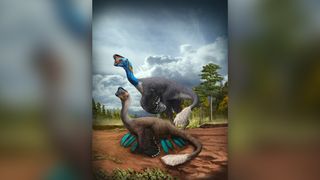'Rarest of the rare' dinosaur fossil found brooding on its eggs
Dinosaur embryos were even preserved in the eggs.

About 70 million years ago, an ostrich-like dinosaur brooding atop a nest of blue-green eggs met its doom, perishing with its nearly-hatched babies in what is now southern China.
Now, the remains of that beast — an oviraptorosaur, or a giant feathered dinosaur that walked on two legs — represent the only dinosaur fossil on record to be found sitting on top of eggs that still contain dinosaur embryos, a new study finds.
"Dinosaurs preserved on their nests are rare, and so are fossil embryos," study lead researcher Shundong Bi, a paleontologist at the Center for Vertebrate Evolutionary Biology at Yunnan University in China, said in a statement. "This is the first time a non-avian dinosaur has been found, sitting on a nest of eggs that preserve embryos, in a single spectacular specimen."
Related: Photos: Fossilized dino embryo is new oviraptorosaur species
These eggs now join the ranks of another famous oviraptorid embryonic egg, known as Baby Louie, whose 90 million-year-old remains were also found in China. (Baby Louie wasn't found in a nest with an adult sitting on it.)
Oviraptorids, which are theropods — a group of mostly meat-eating bipedal dinosaurs that includes Tyrannosaurus rex and Velociraptor — flourished during the Cretaceous period (145.5 million to 65.5 million years ago). This brooding oviraptorid was discovered in rocks dating to the last age of the Cretaceous period, known as the Maastrichtian age (72 million to 65.5 million years ago), alongside the Ganzhou railway station in Jiangxi province.
The fossil isn't complete, as the adult's skull and a few of its bones, including parts of its vertebrae, are missing; but its nest is remarkably well-preserved with the remains of at least 24 oval-shaped eggs. At least seven of those eggs, each about 8.5 inches (21.5 centimeters) long and just over 3 inches (8.5 cm) across, contain bones or partial skeletons of embryonic dinosaurs.

The adult oviraptorid was sitting directly over the clutch, with its forelimbs (or arms) covering the edges of the nest, the researchers wrote in the study. Many of the embryos were about to hatch. This indicates that the adult was likely incubating its eggs, a behavior also seen in modern birds, the descendants of dinosaurs, rather than guarding its nest like a crocodile (crocodiles are archosaurs, meaning they are distant cousins of dinosaurs), the researchers said.
"This kind of discovery, in essence fossilized behavior, is the rarest of the rare in dinosaurs," study co-researcher Matt Lamanna, a paleontologist at the Carnegie Museum of Natural History in Pittsburgh, said in the statement. "In the new specimen, the babies were almost ready to hatch, which tells us beyond a doubt that this oviraptorid had tended its nest for quite a long time. This dinosaur was a caring parent that ultimately gave its life while nurturing its young."
Moreover, an analysis of the oxygen isotopes (atoms with varying numbers of neutrons in their nuclei) in the fossilized eggshells and embryonic dinosaur bones revealed that the eggs were incubated at high temperatures of about 86 to 100 degrees Fahrenheit (30 to 38 degrees Celsius), the researchers said. The team figured this out by comparing the oxygen isotopes in the eggshells, which would have matched the mother's oxygen isotopic makeup because she laid the eggs, with the chemistry of the embryonic bones, which would have changed over time because of the incubation heat applied to them. This finding adds another layer of evidence that the adult oviraptorid was sitting on the nest to keep the eggs warm. In contrast, reptiles tend to keep their eggs at cooler temperatures of about 79 to 90 F (26 to 32 C), the researchers said.
Related: In images: A new look at T. rex and relatives
Some of the embryos were more developed than others, indicating that they were likely laid at different times, the researchers noted. Such asynchronous hatching seems to have evolved independently in oviraptorids and some modern birds, including owls and pelicans, in which eggs can hatch hours to weeks apart.
The adult oviraptorid revealed one more secret; the researchers found a cluster of pebbles near its abdominal region. These pebbles were likely gastroliths ("stomach stones" in Latin) that the dinosaur likely swallowed to help it grind and digest its food. This is the first instance of stones that are clearly gastroliths to be found in an oviraptorid specimen, the researchers said.
"It's extraordinary to think how much biological information is captured in just this single fossil," study senior research Xing Xu, a biologist at the Institute of Vertebrate Paleontology and Paleoanthropology at the Chinese Academy of Sciences, said in the statement. "We're going to be learning from this specimen for many years to come."
The study was published as a peer-reviewed pre-print online in December 2020 in the journal Science Bulletin.
Editor's Note: This story was updated at 1:57 p.m. EDT March 16 to correct the temperature conversions of the eggs.
Originally published on Live Science.
Live Science newsletter
Stay up to date on the latest science news by signing up for our Essentials newsletter.

Laura is the archaeology/history and Life's Little Mysteries editor at Live Science. She also reports on general science, including archaeology and paleontology. Her work has appeared in The New York Times, Scholastic, Popular Science and Spectrum, a site on autism research. She has won multiple awards from the Society of Professional Journalists and the Washington Newspaper Publishers Association for her reporting at a weekly newspaper near Seattle. Laura holds a bachelor's degree in English literature and psychology from Washington University in St. Louis and a master's degree in science writing from NYU.
Most Popular

By Harry Baker

By Ben Turner

By Jamie Carter